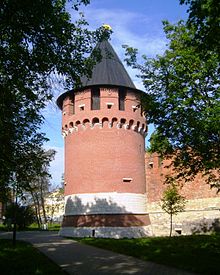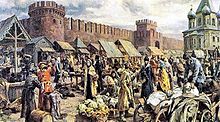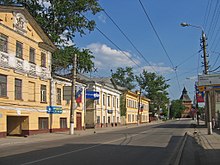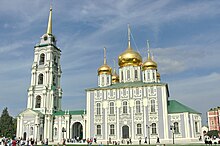Tula Kremlin
The Tula Kremlin ( Russian Тульский кремль ) is a fortress ( Kremlin ) in the Russian city of Tula from the early 16th century . It is the most famous building in the city and one of the most famous Kremlins in Russia.
history
After the city of Tula, which previously belonged to the Ryazan Principality , went to Moscow in 1503 , it became a border town and a southern outpost of Moscow on the foothills of the so-called wild field , i.e. the steppe , which was then mainly inhabited by nomadic peoples . Since the Muscovite Empire was the preferred target of the nomads, especially the Golden Horde and the Crimean Tatars , the Moscow princes felt it was necessary to build a fortress there in order to be able to better defend Moscow, just 200 km further north, in the event of an attack. For this purpose, a protective wall made of trees was planted along the southern principality's borders, which could serve as an obstacle for the attacker in the event of an attack. In addition, the then Moscow ruler Vasily III decided in 1507 . to build a fortress typical of old Russian cities in the middle of the city of Tula on the left bank of the Upa River .
The construction of the fortress began in 1509 with the completion of the oak wall, which was later expanded into a brick wall. In 1514, the architects began with the internal expansion of the fortress, using the Moscow Kremlin as an architectural model. It is not clearly passed down, but it is often assumed that Italian architects were involved in the construction of the Tula Kremlin, as well as the Moscow one.
By 1520, the nine four-story watchtowers on the wall and several residential and church buildings inside the fortress were built. However, the buildings in the Kremlin interior from that time are no longer preserved; the two current church buildings of the Kremlin date from the 18th and 19th centuries. When it was completed, the Tula Kremlin was the only Moscow fortification south of the Oka River .
Over the next few centuries, the Tula Kremlin also proved to be one of the most attack-proof Russian fortresses. As early as 1552, the attack by troops of the Crimean Tatar Khan Devlet I. Giray was successfully repulsed until Tsar Ivan IV sent reinforcement troops with whom the Crimean Tatars could finally be driven from the city. The Tula Kremlin once again served as a fortress when the rebellious peasants around their leader Ivan Bolotnikov stayed here for several months in 1607 to escape the tsarist army. It was only through a complicated trick, namely the damming of the Upa with a dam construction made of sandbags, which ultimately led to a flooding of the Kremlin, that Tsar Vasily IV finally succeeded in bringing the rebels to their knees. In 1953, an obelisk was erected in the Kremlin to commemorate these events .
After tsarist Russia expanded so far south in the 17th century that Tula could no longer be called a border town, the Tula Kremlin also lost its importance as a fortress. Nevertheless, it has remained the central core and an important architectural monument of this city to this day.
Buildings
The most important structures of the Tula Kremlin that have survived to this day are the wall with the towers and the two cathedrals inside the Kremlin - the Assumption Cathedral and the former Apparition Cathedral (now the Arms Museum).
Kremlin wall and towers
The wall of the Kremlin, built on a foundation, has been expanded several times over the centuries and is now up to ten meters high and in places up to 3.2 meters wide. The total length of the wall is 1066 meters; with its tooth-shaped tips, it is reminiscent of the wall of the Moscow Kremlin.
A total of nine towers are built into the wall, four of which also serve as the entrance gates of the Kremlin:
- The Redeemer Tower is located at the westernmost corner of the roughly rectangular Kremlin grounds. Originally, it housed a bell that rang whenever the city was threatened with external threats , which is why this tower was formerly known as the Westovaya Tower - for example, the notification tower .
- The Kazan Tower stands southeast of the Savior Tower and is one of the entrance towers of the Kremlin. Today it is the only one of the nine towers that also serves as a visitor entrance. It gets its name from the icon of Our Lady of Kazan , which was originally built into its facade.
- The Nikitskaya Tower is known for the fact that it used to house a powder depot and a torture cellar.
- The Ivanovo Gate Tower is another entrance tower to the Kremlin. It leads directly into the Kremlin Gardens, which are adjacent to the south-eastern wall.
- The Ivanovskaya tower concealed in the times, was used as the Kremlin as a fortress, a secret underground passage to the Upa out so that the trapped in the Kremlin City defenders could be supplied with water from the river. This corridor was getting on in years and collapsed in the 17th century.
- At that time, the Na pogrebu tower housed rooms in which food, powder and ammunition were stored.
- The water gate tower served as an entrance tower from the river side.
- The Naugolnaya Tower is closest to the Upa bank.
- The tower of the Pyatnitsk Gate lies at the beginning of Pyatnitskaya Street (today Ulitsa Metallistov) and is the entrance tower of the Kremlin on its northwestern section of the wall.
Dormition Cathedral
The Dormition Cathedral ( Успенский собор ) is located in the Kremlin near the entrance from the Kazan Tower and is also the most famous church building in the city. Construction began in 1762, and the outside of the building was finished in just 183 days. It is built of red brick and has a symmetrical construction of five onion domes at the top , including a central one and four smaller ones around it. The interior of the building is also prominent, especially the wall paintings, which were made by 36 master painters from Yaroslavl two years after the building was completed .
Apparition Cathedral
The Apparition Cathedral ( Богоявленский собор ) dates from 1862 and was built in memory of the sons of Tula, who died in the Patriotic War of 1812 . Unlike the Dormition Cathedral, the building is no longer used as a place of worship today: the Tula Arms Museum has been located in its interior since 1982, where the entire history of Tula armaments is presented, as well as a wide variety of swords and firearms from all eras from Russia and others Countries are issued. It is no coincidence that the Apparition Cathedral was chosen as the domicile for the Arms Museum, as it was designed by an architect who had also built several buildings for the Tula arms factory .
Web links
- History of the Tula Kremlin (Russian)
Coordinates: 54 ° 11 ′ 43.1 ″ N , 37 ° 37 ′ 12.7 ″ E






